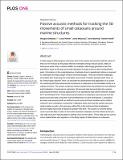Files in this item
Passive acoustic methods for tracking the 3D movements of small cetaceans around marine structures
Item metadata
| dc.contributor.author | Gillespie, Douglas | |
| dc.contributor.author | Palmer, Laura | |
| dc.contributor.author | MacAulay, Jamie | |
| dc.contributor.author | Sparling, Carol | |
| dc.contributor.author | Hastie, Gordon | |
| dc.date.accessioned | 2020-06-01T15:30:02Z | |
| dc.date.available | 2020-06-01T15:30:02Z | |
| dc.date.issued | 2020-05-29 | |
| dc.identifier | 268275289 | |
| dc.identifier | 5fde0b04-f934-44e3-86d6-7e6b9e1ed7f1 | |
| dc.identifier | 000537552800013 | |
| dc.identifier | 85085681251 | |
| dc.identifier.citation | Gillespie , D , Palmer , L , MacAulay , J , Sparling , C & Hastie , G 2020 , ' Passive acoustic methods for tracking the 3D movements of small cetaceans around marine structures ' , PLoS ONE , vol. 15 , no. 5 , e0229058 . https://doi.org/10.1371/journal.pone.0229058 | en |
| dc.identifier.issn | 1932-6203 | |
| dc.identifier.other | RIS: urn:8D5A5E75D8C704B20C036CAF7918A02F | |
| dc.identifier.other | ORCID: /0000-0001-9628-157X/work/75248531 | |
| dc.identifier.other | ORCID: /0000-0002-9773-2755/work/75248620 | |
| dc.identifier.other | ORCID: /0000-0001-7658-5111/work/89178116 | |
| dc.identifier.uri | https://hdl.handle.net/10023/20025 | |
| dc.description | This research was funded through a research grant from the Scottish Government as part of the Marine Mammal Scientific Support Program MMSS/002/15. | en |
| dc.description.abstract | A wide range of anthropogenic structures exist in the marine environment with the extent of these set to increase as the global offshore renewable energy industry grows. Many of these pose acute risks to marine wildlife; for example, tidal energy generators have the potential to injure or kill seals and small cetaceans through collisions with moving turbine parts. Information on fine scale behaviour of animals close to operational turbines is required to understand the likely impact of these new technologies. There are inherent challenges associated with measuring the underwater movements of marine animals which have, so far, limited data collection. Here, we describe the development and application of a system for monitoring the three-dimensional movements of cetaceans in the immediate vicinity of a subsea structure. The system comprises twelve hydrophones and software for the detection and localisation of vocal marine mammals. We present data demonstrating the systems practical performance during a deployment on an operational tidal turbine between October 2017 and October 2019. Three-dimensional locations of cetaceans were derived from the passive acoustic data using time of arrival differences on each hydrophone. Localisation accuracy was assessed with an artificial sound source at known locations and a refined method of error estimation is presented. Calibration trials show that the system can accurately localise sounds to 2m accuracy within 20m of the turbine but that localisations become highly inaccurate at distances greater than 35m. The system is currently being used to provide data on rates of encounters between cetaceans and the turbine and to provide high resolution tracking data for animals close to the turbine. These data can be used to inform stakeholders and regulators on the likely impact of tidal turbines on cetaceans. | |
| dc.format.extent | 16 | |
| dc.format.extent | 1967418 | |
| dc.language.iso | eng | |
| dc.relation.ispartof | PLoS ONE | en |
| dc.subject | QH301 Biology | en |
| dc.subject | DAS | en |
| dc.subject | NERC | en |
| dc.subject | SDG 7 - Affordable and Clean Energy | en |
| dc.subject | SDG 14 - Life Below Water | en |
| dc.subject.lcc | QH301 | en |
| dc.title | Passive acoustic methods for tracking the 3D movements of small cetaceans around marine structures | en |
| dc.type | Journal article | en |
| dc.contributor.institution | University of St Andrews. School of Biology | en |
| dc.contributor.institution | University of St Andrews. Sea Mammal Research Unit | en |
| dc.contributor.institution | University of St Andrews. Scottish Oceans Institute | en |
| dc.contributor.institution | University of St Andrews. Sound Tags Group | en |
| dc.contributor.institution | University of St Andrews. Bioacoustics group | en |
| dc.contributor.institution | University of St Andrews. Marine Alliance for Science & Technology Scotland | en |
| dc.identifier.doi | https://doi.org/10.1371/journal.pone.0229058 | |
| dc.description.status | Peer reviewed | en |
This item appears in the following Collection(s)
Items in the St Andrews Research Repository are protected by copyright, with all rights reserved, unless otherwise indicated.

